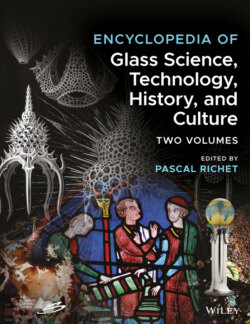Читать книгу Encyclopedia of Glass Science, Technology, History, and Culture - Группа авторов - Страница 208
1 Introduction
ОглавлениеA homogeneous glass by definition lacks a microstructure at a scale larger than a few nanometers. As soon as actual inhomogeneities occur, in contrast, a detailed picture of their size, distribution, composition, and spatial arrangement becomes important to understand the properties of the material. In turn, the improved capabilities of microstructural studies in terms of spatial and elemental resolution are becoming increasingly important to optimize crystallization or phase separation and to achieve the desired microstructure and associated properties (Chapter 7.11). As a matter of fact, the beauty and challenge of glasses and glass ceramics is their diversity and complexity.
The purpose of this chapter thus is to review the main microstructural methods commonly used to study inhomogeneous glass‐based materials. In preamble, however, it is important to note that studying extremely small volumes in great detail can result in “knowing everything about nothing.” In other words, it is critically important to make sure that the information gathered locally is actually representative for larger volumes. To achieve this goal, highly resolved information must be combined with additional integral measurements to get a broad picture. In addition, artifacts introduced upon either preparation or investigation of the sample must be avoided. And one should also be extremely careful with in situ microstructural experiments where, because of dramatic differences in the surface‐to‐volume ratio, annealing can easily lead to results not observed in the bulk. For this reason, one is advised to freeze a microstructure evolution by stopping it at specific steps and to use multiple samples taken from different stages for gaining a “full‐picture” characterization.
When dealing with the early stages of crystallization or nanoscale phase separation, it is obvious that light microscopy is not an appropriate analysis technique because its optical resolution of a few 100 nm, which is limited by the wavelengths of visible light, is two orders of magnitude too low. Fortunately, however, there are various ways to improve spatial resolution. As described in Chapter 2.2, the first is to probe the material with photons of shorter wavelengths such as X‐rays: at 154 pm, the wavelength of Cu‐Kα X‐rays is for instance 1000 times shorter than that of visible light. A second way is to take advantage of the wave‐particle dualism of electrons or ions. Under accelerating voltages of 25 and 200 kV, the electron wavelengths are even shorter than that of typical X‐rays, with values of 8 and 2.5 pm, respectively. As a matter of fact, the former value is typical for studies of sample surfaces by scanning electron microscopy (SEM), whereas the latter applies to investigations by transmission electron microscopy (TEM) of bulk samples with a thickness of a few tens of nanometers at most, to limit electron absorption. In addition to these two techniques, to which we will pay particular attention, the third way to achieve high resolution will also be described. It relies on the use of scanning probes whereby a needle that is atomically sharp at its end is moved over the sample surface by a piezo drive that must be highly precise, since the key to resolution is, in this case, the accuracy of the needle position.
In practice, the formation of a given microstructure can be extremely complicated, including secondary, ternary, or even quaternary phase separation or the nucleation of multiple functional phases on finely dispersed seed crystals [1, 2]. Rather than trying to document all such processes, we prefer to illustrate the capabilities and complementarity of the methods described in this chapter with a single glass ceramics whose starting composition (in mol %) is 50.6 SiO2 · 20.7 MgO · 20.7 Al2O3 · 5.6 ZrO2 · 2.5 Y2O3, whence its MAS acronym from its main components MgO, Al2O3, and SiO2. Under an appropriate temperature and time treatment, this glass transforms to a glass ceramics whose microstructure shows a variety of features with which the pros and cons of the most common techniques are nicely illustrated [3–17]. And this glass ceramics also illustrates how a specific material property can be explained only in microstructural terms: in this instance an unusually high bending strength exemplifies differential expansion strengthening (Chapter 3.12) resulting from precipitation of ZrO2 (zirconia) and MgAl2O4 (spinel), two crystals with high thermal expansion coefficients, in a glassy matrix of lower expansivity.
